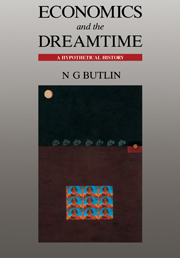Book contents
- Frontmatter
- Contents
- Preface
- Acknowledgements
- Figures
- Maps
- Tables
- Introduction
- Part I The palaeoeconomic history of Aboriginal migration
- Part II Development, structure and function of Aboriginal economy
- Part III Disease, economics and demography
- 12 Introduction
- 13 The problem of an exposed population
- 14 Re-estimating precontact populations
- 15 Turning the models around
- Part IV The establishment of a bridgehead economy: 1788–1810
- Part V The takeover process: 1788–1850
- Bibliography
- Appendix 1 Preliminary model/checklist of Aboriginal migration to Australia
- Appendix 2 NOAA depth contour maps
- Index
13 - The problem of an exposed population
Published online by Cambridge University Press: 06 July 2010
- Frontmatter
- Contents
- Preface
- Acknowledgements
- Figures
- Maps
- Tables
- Introduction
- Part I The palaeoeconomic history of Aboriginal migration
- Part II Development, structure and function of Aboriginal economy
- Part III Disease, economics and demography
- 12 Introduction
- 13 The problem of an exposed population
- 14 Re-estimating precontact populations
- 15 Turning the models around
- Part IV The establishment of a bridgehead economy: 1788–1810
- Part V The takeover process: 1788–1850
- Bibliography
- Appendix 1 Preliminary model/checklist of Aboriginal migration to Australia
- Appendix 2 NOAA depth contour maps
- Index
Summary
Historically, we can recognise a series of post-1788 incidents affecting Australian Aborigines up to 1850. These were:
smallpox epidemics in 1789 and about 1828;
venereal disease, particularly gonorrhea, recognised by 1789 at Botany Bay and probably carried by sealers around the coast by 1800;
a sequence of introduced diseases: influenza in 1820, whooping cough in 1828, influenza and measles in 1840 but also, probably persistently, pneumonia and tuberculosis from 1788;
colonial removal of Aboriginal resources in a minor way from 1788, becoming widespread between 1815 and 1850; and
killing of Aborigines by colonists, intermittently from 1788 but on an increasing scale from 1815.
Killing has become something of a research industry. Amerindian and South American experience suggests strongly that disease was the prime killer. Clearly, that was in conditions of an exposed population lacking immunological defences. Before we can begin to assess the impact of disease on Aborigines, we have to face up to the question: were Australian Aborigines lacking immune defences? Had they been exposed to some and perhaps all colonially introduced diseases before 1788? If so, had they been exposed frequently? The question of frequency is important in that immune defences can disappear as infants are produced (for smallpox) or even after a lapse of time for adults for other diseases. Little immunity is likely, in any event, to have been developed for diseases such as influenza or tuberculosis.
- Type
- Chapter
- Information
- Economics and the DreamtimeA Hypothetical History, pp. 102 - 120Publisher: Cambridge University PressPrint publication year: 1993



